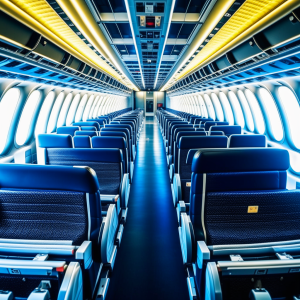Long-haul Budget Flight Survival: 30 tips
Taking a long-haul flight in economy class can be daunting, with small quarters, long transit times, and possible pain. However, do not worry; we are here to make your journey easier with a thorough and well-curated guide. Consider this article to be your passport to a more pleasant and joyful travel experience, ensuring that you enjoy every second of your aerial trip rather than just enduring it.
As experienced travelers, we understand the complexities of flying in economy class. With this understanding, we’ve methodically produced a collection of important insights and professional advice to make your long-haul flight a seamless, pleasant, and even fun experience.
 In the following sections, we’ll go over various tactics and tips, from practical seat selection and outfit choices to in-flight habits that can greatly impact your well-being. From the minute you begin planning your journey until the joyful moment you arrive at your destination, our guide is intended to be your companion, providing a wealth of advice on how to make the most of your time in the air.
In the following sections, we’ll go over various tactics and tips, from practical seat selection and outfit choices to in-flight habits that can greatly impact your well-being. From the minute you begin planning your journey until the joyful moment you arrive at your destination, our guide is intended to be your companion, providing a wealth of advice on how to make the most of your time in the air.
So, dear reader, if you’ve ever found yourself dreading the thought of a long flight in economy class, fear not. This article is a thorough guide, equipping you with the tools and knowledge you need to survive and thrive during those long hours above the clouds. Sit back, relax, and let us provide the ultimate approach to overcoming the problems of long-distance air travel. Happy travels!
- Choose your seat wisely: Consider the advantages of an aisle seat for easy access to the restroom and more legroom. Alternatively, a window seat provides a view and a place to rest your head against the side of the plane. Bulkhead seats often have more legroom, but be aware that they may come with limitations, such as no under-seat storage.
- Dress comfortably: Opt for loose-fitting, breathable clothing made from natural fabrics. Layers are crucial for adapting to the varying temperatures on the plane. Choose comfortable shoes, as feet may swell during the flight, and slip-on shoes make security checks and in-flight shoe removal hassle-free.
- Bring a travel pillow and blanket: Invest in a travel pillow that provides proper neck support. Inflatable pillows are compact and versatile. A cozy, compact blanket can provide comfort during naps, as planes can get chilly.
- Stay hydrated: Dehydration is common during flights due to the dry cabin air. Drink water regularly throughout the flight, and consider bringing a reusable water bottle to avoid reliance on small cups from the cabin crew. Limit caffeine and alcohol intake, as they contribute to dehydration.
- Pack your essential toiletries: In addition to toothbrush and toothpaste, consider facial wipes and a small moisturizer to combat the drying effects of the recycled air. Having these essentials on hand can help you feel refreshed and ready to tackle the next leg of your journey.
- Use noise-canceling headphones: Noise-canceling headphones are a game-changer for a peaceful journey. They block out the plane’s ambient noise and provide a clear audio experience for your entertainment. Create a playlist of your favorite calming music or download podcasts to make the time pass more pleasantly.
- Adjust your watch: Set your watch to the local time of your destination as soon as you board. This simple act helps your body adjust to the new time zone and minimizes the impact of jet lag. Mentally aligning yourself with your destination’s time can also aid in adjusting your activities, such as eating and sleeping.
- Stretch and move: Long periods of sitting can lead to stiffness and discomfort. When the seatbelt sign is off, take the opportunity to stand up, stretch your legs, and walk around the cabin. Perform simple in-seat exercises to promote blood circulation and prevent muscle cramps.
- Avoid heavy meals: Choose light, nutritious meals to avoid feeling bloated and uncomfortable during the flight. Heavy meals can contribute to indigestion and disrupt sleep. Pack some healthy snacks such as nuts, dried fruits, or granola bars to keep hunger at bay between in-flight meals.
- Bring entertainment: Load your tablet, e-reader, or smartphone with various entertainment options. Consider a mix of movies, TV shows, books, and games to keep yourself engaged throughout the journey. Having a variety of choices ensures you can switch between activities based on your mood and energy levels.
- Stay active mentally: Engage your mind with mentally stimulating activities such as puzzles, crosswords, or reading material. A good book or an interesting puzzle can be a welcome distraction during the flight, making the time seem to pass more quickly.
- Pack an eye mask and earplugs: Quality sleep is crucial during a long-haul flight, and these items can significantly enhance your chances of getting some rest. An eye mask blocks out unwanted light, creating a dark environment even if the cabin lights are on. Earplugs help drown out ambient noise, allowing you to create your own quiet space.
- Consider compression socks: Long periods of inactivity can lead to poor circulation, and compression socks are designed to mitigate this risk. Promoting blood flow in the legs reduces the chances of swelling and lowers the risk of deep vein thrombosis (DVT). Compression socks are particularly beneficial during extended flights.
- Be mindful of your posture: Maintaining good posture is essential for preventing backaches and muscle strains during a long flight. Sit with your back against the seat, and consider using a lumbar pillow for extra support. Adjust your seat if needed to ensure proper alignment and comfort.
- Use a moisturizer: The low humidity in the cabin can leave your skin feeling dry and dehydrated. Apply a moisturizer to your face and hands throughout the flight to keep your skin hydrated. Opt for a travel-sized container to comply with liquid restrictions and refresh your skin.
- Bring your own snacks: While airlines provide meals, having your favorite snacks on hand ensures you have options that suit your tastes and dietary preferences. Pack a mix of healthy snacks like trail mix, fruit, or energy bars to keep you fueled and satisfied between in-flight meals.
- Stay warm: Airplanes can be cool, so bring a light jacket or sweater to stay warm during the flight. Dressing in layers allows you to adjust to temperature variations, ensuring you’re comfortable throughout the journey.
- Take advantage of amenities: Airlines often provide amenities such as eye shades, earplugs, and pillows. These small comforts can make a big difference in your overall comfort level. Make use of the amenities offered to enhance your in-flight experience.
- Be kind to your eyes: Prolonged screen time can strain your eyes. Take breaks from electronic devices, close your eyes, and focus on distant objects to give your eyes a rest. This simple practice can help reduce eye fatigue and make the flight more comfortable.
- Stay active during layovers: If you have a long layover, use the time wisely to stretch, walk around, and perform light exercises. This helps combat stiffness and keeps your energy levels up for the next leg of your journey.
- Avoid overpacking: Traveling light is key to a stress-free journey. Pack only the essentials in your carry-on to avoid lugging around unnecessary weight. Keep your essential items easily accessible to streamline security checks and in-flight comfort.
- Stay positive: Maintaining a positive mindset is crucial for a pleasant travel experience. Embrace the adventure, focus on the exciting destination ahead, and try to view the journey as part of the overall experience. A positive attitude can make even the longest flights more enjoyable.
- Use a sleep aid: If you struggle with sleeping on planes, consider consulting your doctor about over-the-counter sleep aids. These can help you relax and get the rest you need during the flight. Ensure you follow any recommended dosage guidelines and are aware of potential side effects.
- Bring extra batteries and chargers: To keep your electronic devices powered throughout the flight, carry spare batteries and portable chargers. This ensures you can continue to enjoy your entertainment, stay connected, and have essential devices ready for use upon arrival.
- Stay connected: Use in-flight Wi-Fi or purchase a data package to stay connected with loved ones and alleviate boredom. Whether sending messages, browsing social media, or catching up on emails, staying connected can make the journey more manageable.
- Prepare for jet lag: Start adjusting your sleeping and eating schedule a few days before your flight to align with your destination’s time zone. Gradual adjustments help your body adapt, reducing the impact of jet lag upon arrival. This proactive approach can make the transition smoother and aid in quicker acclimatization.
- Meditate or practice deep breathing: Find moments of tranquility by incorporating meditation or deep breathing exercises into your routine during the flight. This can help you relax, reduce stress and anxiety, and create a more calming environment in the midst of air travel.
- Respect your neighbors: Being considerate of your fellow passengers is essential for a harmonious flight. Avoid loud conversations, excessive fidgeting, or kicking the seat in front of you. Being mindful of others contributes to a more pleasant experience for everyone on board.
- Pre-book special meals: If you have dietary restrictions, take advantage of the option to pre-book special meals with the airline. This ensures you have suitable food options that align with your dietary needs, making the in-flight dining experience more enjoyable.
- Have a positive arrival routine: Plan a relaxing activity to unwind and kickstart your adventure positively upon reaching your destination. Whether it’s a spa treatment, a leisurely walk, or exploring a nearby landmark, having a positive post-flight routine helps you transition smoothly from travel mode to exploration mode.
Incorporating these detailed strategies into your long-haul flight plan can enhance your overall comfort, well-being, and enjoyment throughout the journey. Safe travels!
Keep Your Cool: A Guide on Surviving a Heatwave
Stay Calm: How to Make It Through a Heat Wave Summer, as pleasant as it is, frequently brings searing temperatures that can be difficult to bear. Heatwaves are known for putting our physical and mental fortitude to the test, resulting in discomfort and even health hazards. Don’t worry, dear readers, because this blog post will […]
Stay One Step Ahead of Winter: Preparing Your Vehicle
Keep One Step Ahead of Winter by Readying Your Car for Any Circumstance There is nothing more stunning than the winter season, with its snow-covered vistas and warm evenings spent by the fireplace. However, in addition to its entrancing allure, winter also carries with it several unanticipated difficulties, particularly when it comes to driving on […]
The Art of Declining Christmas Gatherings
How to Politely Turn Down Expensive Christmas Parties, especially in the current cost of living crisis. Even though Christmas is often linked with happiness, celebrations, and get-togethers, it may also be an exhausting time for people who are experiencing a crisis due to the rising cost of living. During a time that is already difficult, […]
How to Survive a Collapsing Economy
Navigating Economic Uncertainty: A Comprehensive Guide to Preparedness In today’s uncertain economy, it is of the utmost importance to have a solid knowledge of the notion of an economic collapse and the potential effects that it could have on both individuals and society. When the financial system of a nation has a significant breakdown, this […]







